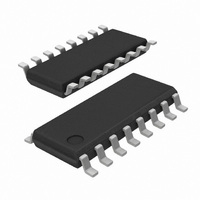SI2493-C-FS Silicon Laboratories Inc, SI2493-C-FS Datasheet - Page 181

SI2493-C-FS
Manufacturer Part Number
SI2493-C-FS
Description
IC ISOMODEM SYSTEM-SIDE 16SOIC
Manufacturer
Silicon Laboratories Inc
Specifications of SI2493-C-FS
Mfg Application Notes
SI2493/57/34/15/04, Appl Note AN93
Data Format
V.21, V.22, V.23, V.29, V.32, V.34, V.90, V.92, Bell 103, Bell 212A
Baud Rates
56k
Interface
UART
Voltage - Supply
3 V ~ 3.6 V
Mounting Type
Surface Mount
Package / Case
16-SOIC (3.9mm Width)
Lead Free Status / RoHS Status
Lead free / RoHS Compliant
Available stocks
Company
Part Number
Manufacturer
Quantity
Price
Company:
Part Number:
SI2493-C-FSR
Manufacturer:
DY
Quantity:
8 623
Part Number:
SI2493-C-FSR
Manufacturer:
SIEMENS/西门子
Quantity:
20 000
Host Interface Troubleshooting
The methods described in this section are useful as a
starting point for debugging a prototype system or as a
continuation of the troubleshooting process described
above. The procedures presented in this section require
a known, good, Si24xxURT-EVB evaluation board and
data sheet. This section describes how to substitute the
evaluation board for the entire modem circuitry in the
prototype system. Substituting a known operational
modem can help to quickly isolate problems. The first
step is to substitute the evaluation board for the
complete modem solution in the prototype system.
Si3008 Troubleshooting section.
If the modem does not go off-hook and draw loop
current as a result of giving the ATH1 command and
receiving an “O” message, begin troubleshooting
with the isolation capacitor at the Si24xx. First, check
all solder joints on the isolation capacitors, Si3008,
and associated external components. If no problems
are found, proceed to the following Troubleshooting
section to verify whether the problem is on the
Si24xx or the Si3008 side of the isolation barrier. If
the problem is found to be on the Si24xx side, check
C50, C51, C53, the corresponding PCB traces, and
the Si24xx pins. Correct any problems. If no
problems are found with the external components,
replace the Si24xx.
If the problem is found to be on the Si3008 side of
the isolation barrier, go to the Si3008
Troubleshooting section.
If the modem does NOT respond with an “O” to the
command ”AT<cr>,”
this indicates the host processor/software is not
communicating with the modem controller, and the
problem can be isolated as follows.
Si24xx Clock is Oscillating
First, be sure the Si24xx is properly reset and
RESET, pin 8, is at 3.3 V. Next, check the DTE
connection with the host system. If this does not
isolate the problem, go to the Host Interface
Troubleshooting section.
Si24xx Clock is Not Oscillating
Check the voltage on the Si24xx, pin 4, to be sure
the chip is powered. Also, check that pin 12 is
grounded. Next, check the solder joints and
connections (PCB traces) on C40, C41, Y1, and the
Si24xx, pins 1 and 2. Measure C26 and C27 (or
replace them with known good parts) to ensure they
are the correct value. If these steps do not isolate the
problem, replace the Si24xx.
Rev. 0.9
This immediately demonstrates whether any modem
functionality problems are in the prototype modem
circuitry or in the host processor, interface, or software.
Troubleshooting
Connect Evaluation Board isolation capacitors to
Prototype Modem Si3008. Remove C1 on the
evaluation board and on the prototype system. Solder
one end of the evaluation board, C1, to the Si24xx-side
pad leaving the other end of C1 unconnected. Next,
solder a short jumper wire from the unconnected side of
C1 on the evaluation board to the Si3008-side C1 pad
on the prototype system. This connection is illustrated in
Figure 47. Connect the phone line to the prototype
system RJ-11 jack.
Power up and manually reset the evaluation board;
then, power up the prototype system. Attempt to make a
connection using the host processor and software, the
evaluation board, Si24xx, and the prototype system
Si3008 and associated external components. If this
connection is successful, the problem lies with the PCB
layout, the external components associated with the
Si24xx, or the Si24xx device itself.
Verify Si24xxURT-EVB Functionality
Connect the evaluation board to a PC and a phone
line or telephone line simulator. Using a program
such as HyperTerm, make a data connection
between the evaluation board and a remote modem.
Remove power and the RS232 cable from the
evaluation board and proceed to the next step.
Connect Evaluation Board to Prototype System
Completely disconnect the embedded modem from
the host interface in the prototype system. Connect
the Si24xxURT-EVB to the host interface using JP3
as described in the Si24xxURT-EVB data sheet
section titled Direct Access Interface. This
connection is illustrated in Figure 45. Be sure to
connect the evaluation board ground to the
prototype system ground. Power up and manually
reset the evaluation board; then, power up the
prototype system and send “AT<cr>.” If an “OK”
response is received, make a connection to the
remote modem as in the previous step. If no “OK”
response is received, debug host interface and/or
software. If a connection is successfully made, go to
the next step to isolate the problem in the prototype
modem.
An alternative approach is to connect the prototype
modem to the Si24xxURT-EVB motherboard in place
of the daughter card, and use a PC and HyperTerm
to test the prototype modem. See Figure Figure 46
for details.
AN93
181












